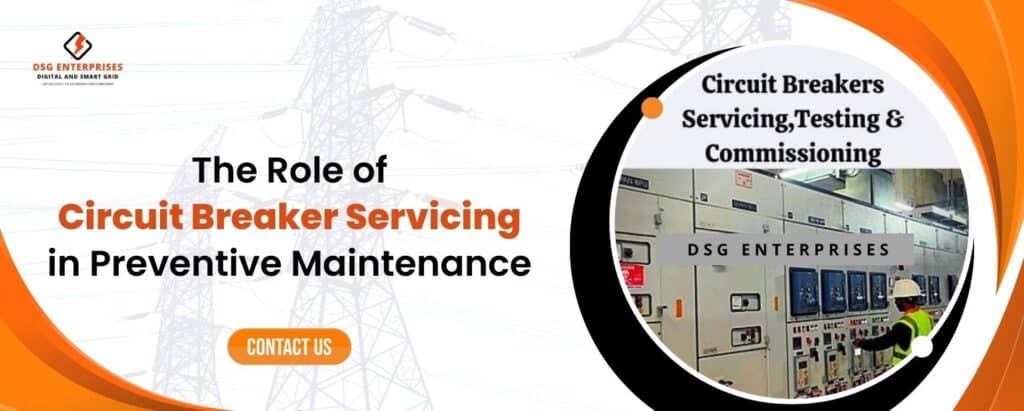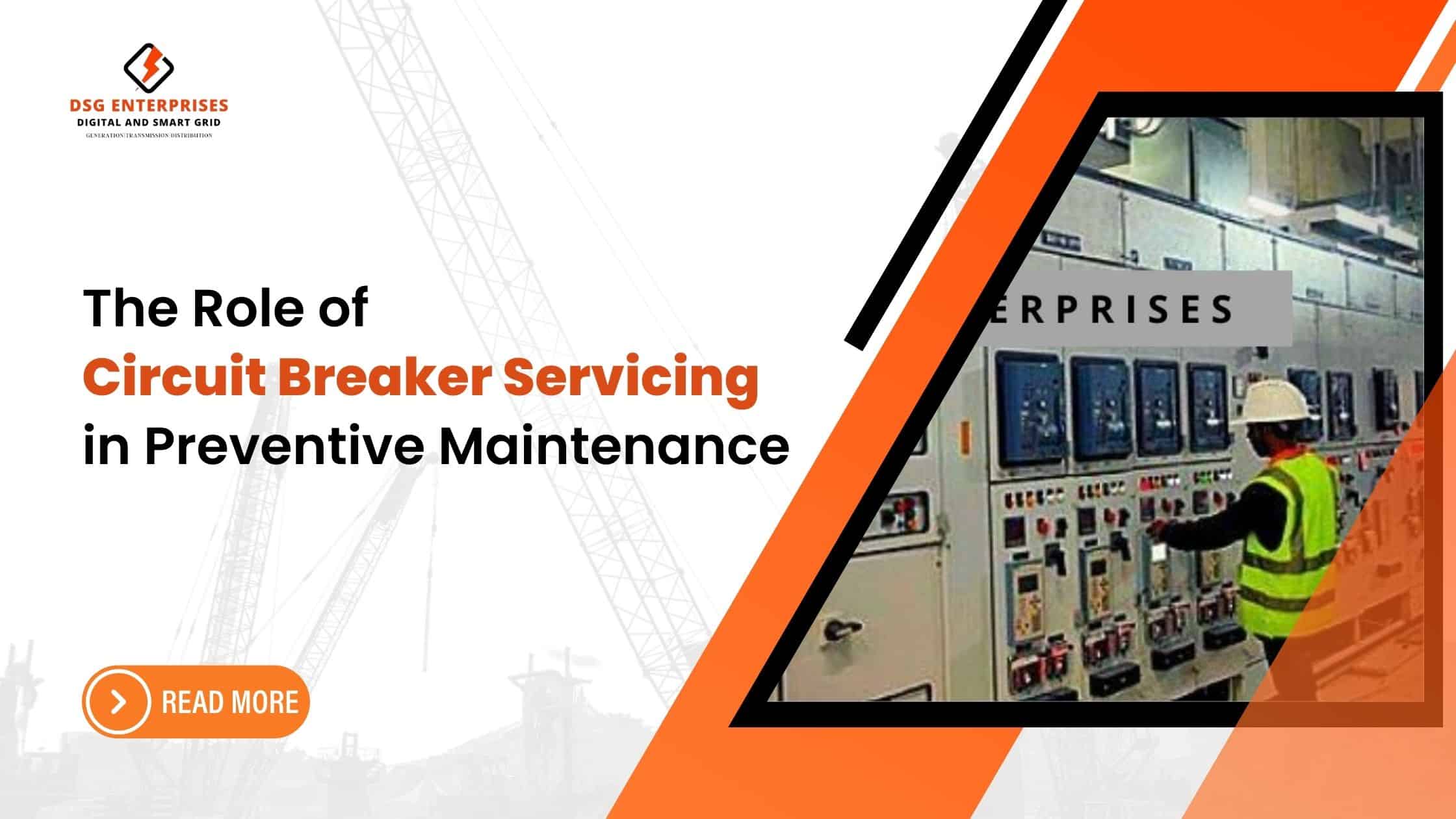In modern electrical power systems, Circuit Breakers Servicing plays an indispensable role in ensuring reliable protection against faults and ensuring continuity of service. From low voltage (LV) to extra high voltage (EHV) levels, these devices operate in both routine and emergency conditions, safeguarding electrical grids, industrial plants, and commercial infrastructures from overcurrent, short circuits, and other hazards. However, like any other mechanical equipment, circuit breakers undergo wear and tear, making servicing, testing, and commissioning essential for their optimal performance.
Preventive maintenance in the form of testing and commissioning of circuit breakers ensures that equipment remains reliable and operates smoothly under all conditions. Proper maintenance not only extends the lifespan of circuit breakers but also minimizes unexpected downtime, catastrophic failures, and costly repairs. In this blog, we will explore the critical role of circuit breaker servicing in preventive maintenance and how it ensures the stability of power systems.
Importance of Circuit Breakers Servicing in Preventive Maintenance.
Testing and commissioning of circuit breakers involves the comprehensive examination and repair of a breaker’s mechanical and electrical components. By adhering to a scheduled maintenance plan, operators can detect potential issues before they escalate into serious problems. This proactive approach is especially important in high-risk environments, such as substations, industrial plants, and critical infrastructure, where system failures can lead to extensive damage, financial losses, or safety hazards.
Our expert team offers extensive circuit breaker testing, commissioning, and servicing across all voltage levels, including LV, MV, HV, and EHV. By working across a wide range of breaker types and voltage levels, we help customers ensure that their systems are reliable and safe. This comprehensive service includes air-insulated (AIS) and gas-insulated switchgear (GIS) breakers, both of which have unique requirements for testing and maintenance.
Through regular servicing, operators can verify that circuit breakers are functioning properly, whether they are protecting small commercial buildings or large utility substations. This boosts overall system reliability, helping to prevent power outages, equipment failures, and other operational disruptions.

Offline Testing and Commissioning in Preventive Maintenance
Offline testing refers to tests conducted when the breaker is isolated from the power system. This method is ideal for comprehensive evaluations of breaker performance, allowing technicians to diagnose and address mechanical or electrical issues without the pressure of real-time operation.
- Insulation Resistance Measurement: Ensuring that the insulation materials are intact and effective in preventing leakage currents, which could lead to breakdowns or faults.
- Dynamic Contact Resistance Measurement (DCRM): Evaluating the condition of the contacts during operation to detect any wear, erosion, or contamination that could affect the breaker’s performance.
- State Contact Resistance Measurement (CRM): Checking the resistance in the closed state to ensure minimal power loss and optimal performance.
- Timing Measurement: Assessing the opening and closing times of the breaker, which is crucial for coordination with protective relays.
- SF6 Gas Dew Point Measurement: Measuring moisture content in SF6 gas to prevent condensation that can compromise insulation and lead to faults.
- SF6 Gas Leakage Test: Ensuring that there are no leaks in the breaker, as SF6 is an effective insulating gas, and any leakage can reduce the breaker’s operational reliability.
- Vacuum Interrupter Test (VIDAR): Used for vacuum circuit breakers (VCBs), this test checks the integrity of the vacuum, ensuring the arc extinguishing capabilities remain intact.
- Functional Check (Remote Trial): Testing the breaker’s response to control signals remotely to ensure it will operate correctly in an actual scenario.
Online Testing and Commissioning in Preventive Maintenance
Online testing involves examining the breaker while it is still connected to the power system, providing real-time data on its performance under actual operational conditions.
- Partial Discharge Measurement: Monitoring the presence of partial discharges, which are small electrical sparks that could signal insulation degradation in switchyard equipment.
- Thermography: Utilizing infrared cameras to detect abnormal temperature variations that could indicate issues such as loose connections, contact degradation, or overheating.
By performing a combination of online and offline tests, technicians can obtain a comprehensive assessment of the breaker’s condition and performance. Timely intervention based on these findings can prevent minor issues from evolving into major faults.
Comprehensive Circuit Breakers Servicing
Circuit Breakers Servicing involves thorough cleaning, mechanical adjustments, lubrication, and the replacement of worn-out parts. Our team follows a systematic approach to ensure that every part of the breaker is functioning optimally. This methodical servicing includes:
- Cleaning of the Breaker: Regular cleaning of the breaker using CRC to remove dust, moisture, and contaminants that can compromise the device’s performance.
- Lubrication: Old grease is removed, and new, recommended grease is applied to moving parts to ensure smooth operation and prevent friction-based wear and tear.
- Inspection of Contacts: Both arcing and fixed/moving contacts are examined for signs of wear. Any excessive wear can increase resistance, causing heat buildup, and may lead to eventual failure.
- Reset Mechanism Check: Ensuring the breaker resets correctly after operation, preventing false trips and ensuring that it will operate when needed.
- Tripping Mechanism Verification: The tripping of the breaker is verified through push buttons, protection releases, and manual intervention. This is crucial to ensure the breaker will isolate faults when they occur.
- Tightening of Hardware: All hardware, including screws, bolts, and circlips, is checked for tightness to avoid mechanical failures during operation.
- Motor and Coil Operation Check: Technicians test the motor’s operation in motorized breakers and verify the coil’s functionality to ensure the breaker closes and opens properly in automatic systems.
- CT Health Check: Current transformers (CTs) are checked to ensure they accurately detect and communicate fault conditions to protective relays.
- Protection System Testing: Technicians verify the protection system settings using secondary injection to ensure correct configuration for responding to overcurrent, short circuits, and earth faults.
Preventing Failures and Extending Equipment Life
Routine servicing and testing not only prevent unexpected failures but also help extend the life of Testing and commissioning of circuit breakers. Regular maintenance allows technicians to identify worn-out components and replace them before they fail. This proactive approach avoids sudden outages, minimizes repair costs, and optimizes the lifecycle of the breaker.
Conclusion
Circuit Breakers Servicing plays a critical role in ensuring the uninterrupted operation of electrical systems across various voltage levels, from LV to EHV. By incorporating preventive maintenance practices such as regular testing, commissioning, and comprehensive servicing, operators can significantly reduce the risk of unexpected failures, enhance safety, and improve overall system reliability. Circuit breakers are the first line of defense against electrical faults, and their proper maintenance ensures that this defense remains strong.
Moreover, investing in preventive maintenance through Testing and commissioning of circuit breakers not only extends the life of the equipment but also reduces long-term costs associated with emergency repairs and unplanned outages. It allows for early detection of potential issues, empowering facility managers to address problems before they lead to significant disruptions or hazards. This proactive approach is especially crucial in critical infrastructure environments, where downtime can lead to extensive financial and operational losses.
Ultimately, Circuit Breakers Servicing should be a cornerstone of any maintenance strategy. With a focus on both offline and online testing, detailed inspections, and the replacement of aging components, regular servicing ensures that circuit breakers will continue to perform their protective function efficiently.
At Digital & Smart Grid Enterprises, we take pride in being the leading Circuit Breakers Servicing Provider in Mumbai. Our commitment is to deliver tailored relay solutions that meet various industry requirements. Whether you have questions or wish to make a purchase, feel free to contact us for Circuit Breakers Servicing Cost at +917021624024 or via email at marketing@dsgenterprises.in. With our deep expertise in Circuit Breakers Servicing, we guarantee consistent support throughout your journey. Discover our extensive product range by clicking here for more information.



